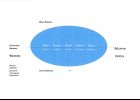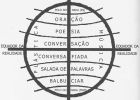Flusser’s Philosophy of Science
Many of Flusser’s books and essays refer to “science”, “epistemology”, and “knowledge”. His ways of conceptualizing these terms, however, remain to be explored in detail. To my knowledge, there is no secondary literature that analyzes “Flusser’s philosophy of science”. In this paper, I begin outlining such a project. I offer two translations of unpublished manuscripts, “La creation scientifique et artistique” (“Scientific and artistic creativity”) and “Wissenschaft, Weisheit (und Judentum)” (“Science, Wisdom (and Jewishness)). Based on an initial and very superficial analysis, I suggest locating Flusser’s concept of science at the center of a triangle of reciprocal relationships between philosophy, art, and religion.
Até a terceira e a quarta geração: a experiência do holocausto como fundamento das teorias de Vilém Flusser / Unto the Third and Fourth Generation. The Experience of the Holocaust as the Basis of Vilém Flusser’s Philosophy / Do třetího i čtvrtého pokolení
This essay focuses on the fundamental significance of the Holocaust in Vilém Flusser’s life and thinking. In his still unpublished Até a terceira e a quarta geração (Unto the Third and Fourth Generation) written in the early 1960ies, the problem of Nazism is explicitly thematized and linked to the development of Western society. The abandonment of a religious view of the world in the Renaissance led to the loss of a grounding sense of reality, which was filled up by science (the new religion) and later on by nationalism. These developments eventually led to the First and the Second World War, as well as to Auschwitz and Adolf Eichmann as the ideal representatives of the apparatus and the functionary.
„Ich habe gegen Pathos zu kämpfen gehabt […].“ Zur Entstehung und Bedeutung von Vilém Flussers Das Zwanzigste Jahrhundert. Versuch einer subjektiven Synthese
This essay deals with Vilém Flusser’s first finished, but still unpublished book Das Zwanzigste Jahrhundert, which was most probably written in the mid-1950s. The book consists of six chapters linked to each other in an unfolding spiral: politics, society, science, art, philosophy and religion. Flusser’s main aim is to try to synthesize the West with the East: modern Western science with the Indian philosophy of the Vedanta, the contemporary Western concept of art with that of Chinese culture and the Judaic-Christian belief with Hinduism and Buddhism. This synthesis is possible because the West and the East have been slowly evolving in the same direction. The book is remarkable both from a thematic and a stylistic point of view. It is the very origin, and construction site of Flusser’s work to come. Flusser has discarded some of the ideas put forward in Das Zwanzigste Jahrhundert, but retained many others transforming them over the course of the years. Furthermore, Das Zwanzigste Jahrhundert allows a reflection on the origins of Flusser’s writing, and on the development of his style.
O misterioso Romy Fink, personagem de “Bodenlos”
Romy Fink (1912-1972) was a lawyer, an art dealer and an English mystic who lived in Brazil. Flusser understood Fink’s life as expressing the moral and existential values of Judaism.
Religião, sagrado e mito em Vilém Flusser
Beginning with Flusser’s early writing on language Language an Reality and the History of the Devil, where God and the Devil appear as mere procurers of the human will by giving sense to God’s creations, Braz Teixeira shows the significance of Religion, the Sacred an Myth in the entire work of Vilém Flusser. Beside his later divergence from most Brazilian thinkers, primarily the so called School of São Paulo, including Vicente Ferreira da Silva, Flusser expresses his interest in religion, in the notions of myth and ritual, and in the significance of sacrifice with the idea that language not only determines what we call natural, but also tries to reach that which is beyond the natural. In the vision of Flusser religion would be the human capacity to understand the sacred dimension of the world, revealing the radical opacity of things. For the author of Natural:mente, myths have a sacred content, but not an immediate manifestation. They are the parting points for history and, depicting the primary structures of our behavior, they are equally the highest expressions of language.


